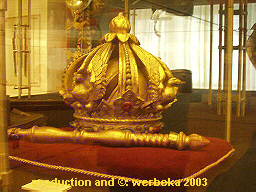The Crown of the Austrian Empire (German: Österreichische Kaiserkrone or Krone des Kaisertums Österreich) was originally the personal crown of emperor Rudolf II. It is therefore also known as the Crown of Rudolf II, or the Crown of the Austrian Empire.
Circlet
The mitre symbolises the divine right to rule, and the spiritual position of the emperor: during the coronation, he was also consecrated symbolically as a deacon. It is turned by 90 °, the areas are shown to the side, so that the high arch goes from the front to the back, just as in the Imperial Crown of the Holy Roman Empire. The mitre is made out of gold, with a band of enamel work, which depicts birds and plants. The mitre is divided into four sections, which represent the high honours of Rudolf II. The first part shows him kneeling, while receiving the Imperial Crown of the Holy Roman Empire in Regensburg as Holy Roman Emperor. The second shows him riding onto the coronation hill in Bratislava during his coronation as King of Hungary. The third shows his coronation procession through Prague as King of Bohemia, and the fourth depicts an allegory of his victory over the invading Turks, although historically that is not quite correct. The inscription inside the arch reads in Latin: RVDOLPHVS II ROM(ANORVM) IMP(ERATOR) AVGVSTUS HVNG(ARIAE) ET BOH(EMIAE) REX CONSTRVXIT MDCII (Made for Rudolf II, Roman Emperor, King of Hungary and Bohemia, in 1602).
Mitre
The high arch was obviously inspired by the arch from the Imperial Crown of the Holy Roman Empire. It is studded with eight diamonds, which symbolise Christ. The emperor was regarded as governor on earth in the name of Christ. At the top of the arch is a blue-green emerald, which symbolises heaven. The emerald was not cut, but polished.
 High Arch
High ArchAlso belonging to the crown are a sceptre and the Imperial Orb, which was commissioned in 1612 by Rudolf's brother and successor Matthias. It was created by Andreas Ochsenbruck. The shape takes its inspiration from the crown, especially the enamel-work has been copied in its style. A peculiarity of the sceptre is that is made partly out of "unicorn horn". The sceptre and the orb were already in use before proclamation of the Empire of Austria, sometimes as the Bohemian royal regalia, sometimes for the hereditary private estates (Erbhuldigung) of the Archduchy of Austria.
Crown, sceptre, and orb are kept today in the Schatzkammer Imperial Treasury, in the Hofburg Palace in Vienna, Austria.
Sceptre and Imperial Orb
A number of beer companies feature the Imperial Crown on their logo, such as the Royal Brewery of Krušovice (cs: Královský Pivovar Krušovice) in the Czech Republic.
Some cities have their coat of arms crowned by the Imperial Crown. Amsterdam, was granted its coat of arms to be crowned by emperor Maximilian I in 1489 in recognition of its financial support for one of his wars. See also
Weltliche und Geistliche Schatzkammer. Bildführer. Kunsthistorischen Museum, Vienna. 1987. ISBN 3-7017-0499-6
Fillitz, Hermann. Die Schatzkammer in Wien: Symbole abendländischen Kaisertums. Vienna, 1986. ISBN 3-7017-0443-0
Fillitz, Hermann. Die Österreichische Kaiserkrone und die Insignien des Kaisertums Österreich, Vienna, 1973. ISBN 3-7008-0015-0
No comments:
Post a Comment